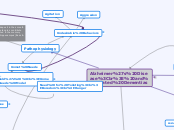по Jennifer Maurer 6 лет назад
224
Alzheimer's Disease
Alzheimer's disease, a leading neurodegenerative condition primarily affecting the aging population, impacts millions of Americans and stands as the sixth highest cause of death in the country.

по Jennifer Maurer 6 лет назад
224

Больше похоже на это
Sporadic Late-Onset Alzheimer's disease (AD) does not have a specific gene association; however, the cellular pathology is the same as that for gene-associated early and late-onset AD (Boss & Huether, 2018).
Alzheimer's Association. (2018). Facts and Figures. Retrieved from Alzheimer's Association: https://alz.org/alzheimers-dementia/facts-figures
Boss, B. J., & Huether, S. E. (2018). Alterations in Cognitive Systems, Cerebral Dynamics, and Motor Function. In K. L. McCance, & S. E. Huether, Pathophysiology. The Biologic Basis for Disease in Adults and Children (pp. 504-549). St. Louis: Elsevier.
Cohen-Mansfield, J., Dakheel-Ali, M., Marx, M. S., Thein, K., & Regier, N. G. (2015). Which unmet needs contribute to behavior problems in persons with advanced dementia?. Psychiatry research, 228, 59-64.
Jutkowitz, E., Brasure, M., Fuchs, E., Shippee, T., Kane, R. A., Fink, H. A., ... & Kane, R. L. (2016). Care‐delivery interventions to manage agitation and aggression in dementia nursing home and assisted living residents: a systematic review and meta‐analysis. Journal of the American Geriatrics Society, 64, 477-488.
McCance, K. L., Grey, T. C., & Rodway, G. W. (2018). Altered Cellular and Tissue Biology. In K. L. McCance, & S. E. Huether, Pathophysiology. Biologic Basis for Disease in Adults and Children (pp. 46-104). St. Louis: Elsevier.
Murray, M. E., Lowe, V. J., Graff-Radford, N. R., Liesinger, A. M., Cannon, A., Przybelski, S. A., ... & Ross, O. A. (2015).
Clinicopathologic and 11C-Pittsburgh compound B implications of Thal amyloid phase across the Alzheimer’s disease spectrum. Brain, 138, 1370-1381.
Park, L., Uekawa, K., Garcia-Bonilla, L., Koizumi, K., Murphy, M., Pistik, R., ... & Anrather, J. (2017). Brain perivascular macrophages initiate the neurovascular dysfunction of Alzheimer Aβ peptides. Circulation research, 121(3), 258-269.
In 2017, it was estimated that 5.5 million Americans have been diagnosed with Alzheimer’s disease, noting that Alzheimer’s is the sixth highest cause of death in America (Alzheimer's Association, 2018).
Inclination for Mood swings r/t impaired cognition. Anxiety, Hosility, Emotional labile behaviors are common.
Cohen-Mansfield’s Unmet Needs Model states that “problem behaviors of people with dementia result from unmet needs stemming from a decreased ability to communicate those needs and to provide for oneself” (Cohen-Mansfield, Dakheel-Ali, Marx, Thein, & Regier, 2015).
Undesirable behaviors are described as any verbal or motor activity that does not seem purposeful or appropriate to the situation, including increased motor activity and irritability (Jutkowitz, et al., 2016)
Alzheimer’s disease (AD) is the most prevalent neurodegenerative disease that mostly affects the aging population (Park et al., 2017)
DNA methylation affects the expression level of neuronal function-related genes in AD patients (Park et al., 2017)
During normal metabolism, the mitochondria are the greatest source and the target of Reactive Oxygen Series, or ROS. Mitochondrial oxidative stress has been implicated in heart disease, Alzheimer's disease, and Parkinson's disease, as well as aging itself (McCance, Grey, Rodway, 2018).
Alzheimer’s disease is a multi-proteinopathy, involving both extracellular amyloid-β deposits (i.e. amyloid-β plaques) and intracellular accumulation of post-translationally modified tau proteins (Murray et al., 2015)